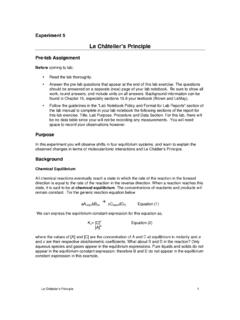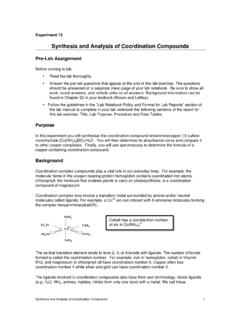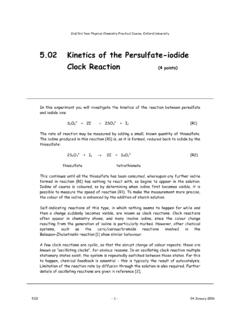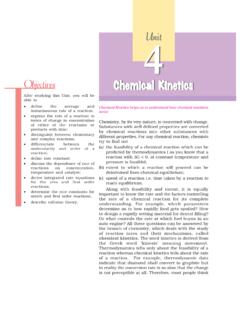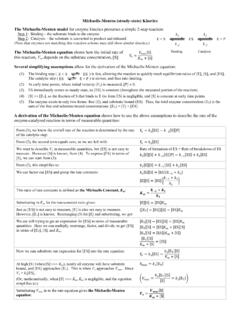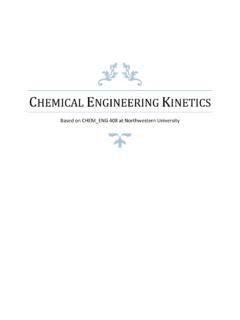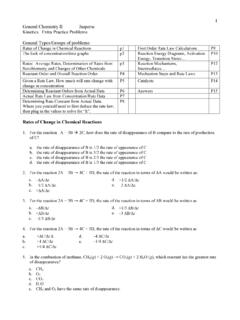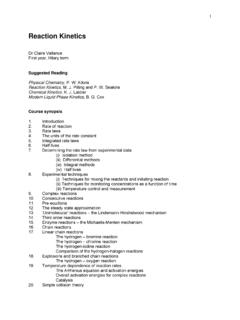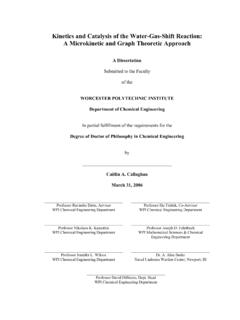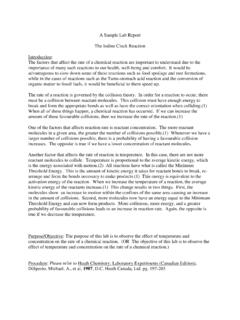Transcription of The Kinetics of the Iodine Clock Reaction
1 The Kinetics of the Iodine Clock Reaction 20 Experiment 2 The Kinetics of the Iodine Clock Reaction Pre-lab Assignment Before coming to lab: x Read the lab thoroughly. x Answer the pre-lab questions that appear at the end of this lab exercise. The questions should be answered on a separate (new) page of your lab notebook. Be sure to show all work, round answers, and include units on all answers. Background information can be found in Chapter 14, especially sections in your textbook (Brown and LeMay). x Follow the guidelines in the "Lab Notebook Policy and Format for Lab Reports" section of the lab manual to complete in your lab notebook the following sections of the report for this lab exercise: Title, Lab Purpose, Procedure and Data Tables. Background In this experiment you will determine the effect of concentration upon the rate of the Reaction of bromate ions (BrO3-) with iodide ions (I-) and hydrogen ions (H+).
2 In addition you will determine the effect of temperature changes on the rate of the Reaction , the amount of energy required for molecules to react (called the activation energy), and the effect of a catalyst on the rate of the Reaction . Factors Affecting Rates of reactions On the basis of previous experiments you've performed, you probably have already noticed that reactions occur at varying speeds. There is an entire spectrum of Reaction speeds, ranging from very slow to extremely fast. For example, the rusting of iron is reasonably slow, whereas the decomposition of TNT is extremely fast. The branch of chemistry that is concerned with the rates of reactions is called chemical Kinetics . Understanding Reaction rates helps us control them and adjust conditions to make them useful. For example, refrigeration of foods allows us to slow down the reactions involved in food spoilage while catalytic converters in cars increase the rate at which pollutants are converted to harmless gases.
3 Experiments show that rates of reactions in solution depend upon: 1. The nature of the reactants 2. The concentration of the reactants 3. The temperature 4. The presence of a catalyst. All of these factors rely on one basic underlying principle: Before a Reaction can occur, the reactants must come into direct contact with each other by way of collisions. In addition, the reacting particles must collide with sufficient energy to result in a Reaction (break bonds within a molecule); if the reactant particles do not collide frequently or do not collide with very much energy, the Reaction will be proceed slowly or not at all. Looking at these factors individually: The Kinetics of the Iodine Clock Reaction 21 Concentration: Changing the concentration of a solute in solution alters the number of particles per unit volume. The more particles present in a given volume, the greater the probability of them colliding.
4 Hence, increasing the concentration of a solute in solution increases the number of collisions per unit time and therefore, increases the rate of Reaction . Temperature: Since temperature is a measure of the average kinetic energy of a substance, an increase in temperature increases the kinetic energy of the reactant particles. The results in an increase in the velocity of the particles and therefore, increases the number of collisions between them in a given period of time. Thus, the rate of Reaction increases. Also, an increase in kinetic energy results in a greater proportion of the collisions having the required energy for Reaction . A good rule of thumb is that for each 10o C increase in temperature, the rate of Reaction doubles. Catalyst: A catalyst is a substance that speeds up a Reaction but undergoes no permanent chemical change itself. Catalysts increase the rate of a Reaction by providing an alternative route to the Reaction - one that requires less energetic collisions between reactant particles.
5 If less energy is required for a successful collision, a larger percentage of the collisions will have the required energy, and the Reaction will occur faster. The Rate Law In order to relate the rate of a Reaction to the factors discussed above, chemists write rate laws for reactions . The rate law of a chemical Reaction is a mathematical equation that describes how the Reaction rate depends upon the concentration of each reactant. Consider the hypothetical Reaction : A+B C+D In general, the rate of the Reaction will depend upon the concentration of the reactants. Thus, the rate of our hypothetical Reaction above may be expressed as: Rate = k[A]x[B]y where [A] and [B] are the concentrations of A and B in units of molarity, and x and y are called the order of the Reaction (the powers to which the respective concentrations must be raised to describe the rate). The orders of the Reaction (x and y) can only be determined experimentally and are typically 0, 1, 2, or a fraction such a.
6 They are not the coefficients of the Reaction ! The rate constant is given the symbol k and its value changes depending upon the Reaction being studied and the temperature of the Reaction as we shall see in this experiment. In this experiment, we shall use the method of initial rates to determine the numerical values of x and y and the value of k. The Kinetics of the Iodine Clock Reaction 22 Example Finding the Rate Law Using the Method of Initial Rates Consider the Reaction : 2NO+2H2 N2 +2H2O The rate law would be: Rate = k[NO]x[H2]y To give be more complete rate law, you will need to find the values of x, y, and k using experiment data. Consider the following data where the rate of the Reaction was measured as the initial concentration of NO and H2 were varied. Experiment [NO] [H2] Initial rate in M/s 1 M 2 M 3 M To see the effect of changing the concentration of NO, find two experiments where only the concentration of NO is changing experiment 1 and experiment 2 in this example.
7 The rate laws for these experiments would be Rate1 = = k[ ]x[ ]y Rate2 = = k[ ]x[ ]y You can determine the effect of changing the concentration of NO by taking a ratio and solving for x: Rate 2 = = k[ ]x[ ]y = [ ]x = Rate 1 k[ ]x[ ]y [ ]x = Taking the logarithm of each side of the equation allows us to solve for y. Kinetics requires familiarity with powers and logarithms. Review both if necessary. log = x x= log = log Similarly, to see the effect of changing the concentration of H2, you can examine experiments 2 and 3 where only the concentration of H2 is changing. The rate laws for these experiments would be Rate3 = = k[ ]x[ ]y Rate2 = = k[ ]x[ ]y You can determine the effect of changing the concentration of H2 by taking a ratio and solving for y: Rate 3 = = k[ ]x[ ]y = [ ]y = Rate 2 k[ ]x[ ]y [ ]y = You can see that y =1.
8 (You could take the log of both sides as done above to show this.) The Kinetics of the Iodine Clock Reaction 23 Part A: Finding the Rate Law Using the Method of Initial Rates The Iodine Clock Reaction is a well-known and memorable chemical Reaction where two colorless solutions are mixed and, after a period of time ranging from seconds to minutes, the solution suddenly turns from colorless to colored (yellow or bluish black. It is represented by the following balanced chemical equation: 6I (aq) + BrO3 (aq)+6H+ (aq) 3I2 (aq) + Br (aq) +3H2O (l) (slow) Equation 1 A starch indicator, which turns yellow or blue-black in the presence of the product Iodine (I2), is also added to the Reaction mixture. However, the color does not show right away because a second Reaction takes place in which thiosulfate ions (S2O32-) consume the product Iodine molecules (I2) as soon as they are produced as shown by Equation 1: I2 (aq) + 2 S2O32-(aq) 2 I-(aq) + S4O62-(aq) (fast) Equation 2 I2 (aq) + Starch Starch-I2(aq) (bluish-black) (fast) Equation 3 Since the first Reaction is slow, and the second is fast, the Iodine molecules (I2) are not present long enough to react with the starch and produce the color.)
9 It is only after all of the S2O3 2 in Equation 2 has been used up that Iodine accumulates, then combines with the starch, and the solution turns yellow or bluish black. Although three reactions are involved, the Reaction between bromate and iodide ions (eqn 1) is the one we will be studying in this experiment. The second Reaction (eqn 2) is only used to delay the Reaction between Iodine and starch (eqn 3). Example continued The rate, therefore, is Rate = k[NO]2[H2]1 We say that the Reaction is second order with respect to NO, first order with respect to H2, and third order overall. The rate constant, k, can be determined using the rate law and the data from any one of the experiments (any of the three would give the same answer). Using the data for run 1, M/s = k[ ]2[ ]1 M/s = k [ ]2[ ]1 71 1/M2 * s = k You can view a similar example worked out at: The Kinetics of the Iodine Clock Reaction 24 For the Reaction we will be studying 6I (aq) + BrO3 (aq)+6H+ (aq) 3I2 (aq) + Br (aq) +3H2O (l) (slow) Equation 1 The rate law for this Reaction will be of the form: Rate = k[I ]x[BrO3 ]y[H+ ]z Your goal is to find the values of x, y, z and k in order to complete the rate law.
10 We will also get the value of a 'hidden parameter,' the activation energy (Ea), which tells us how the rate changes when we change the temperature. Finally, we can investigate the effect of adding a catalyst, which increases the rate by providing a different set of 'steps' requiring less energy for converting the reactants into products. The method of initial rates allows the values of these orders to be found by running the Reaction multiple times under controlled conditions and measuring the rate of the Reaction in each case. All variables are held constant from one run to the next, except for the concentration of one reactant. The order of that reactant in the rate law can be determined by observing how the Reaction rate varies as the concentration of that one reactant is varied. This method is repeated for each reactant until all the orders are determined. At that point, the rate law can be used to find the value of the rate constant (k) for each trial. If the temperatures are the same for each trial, then the values of k should be the same too.


